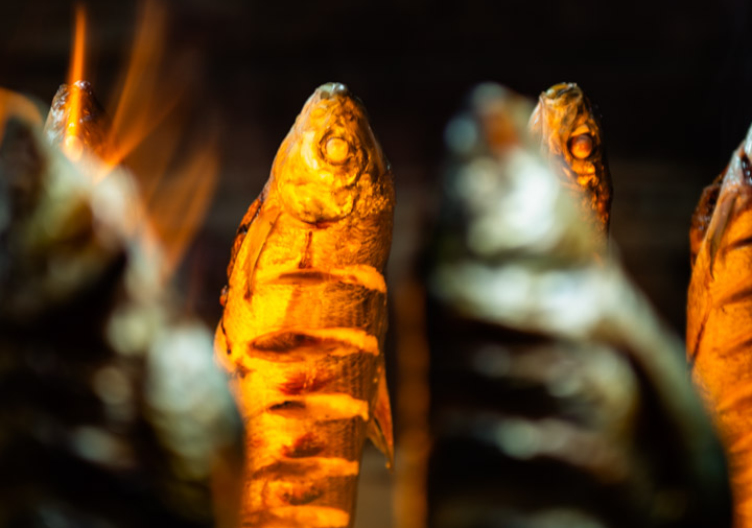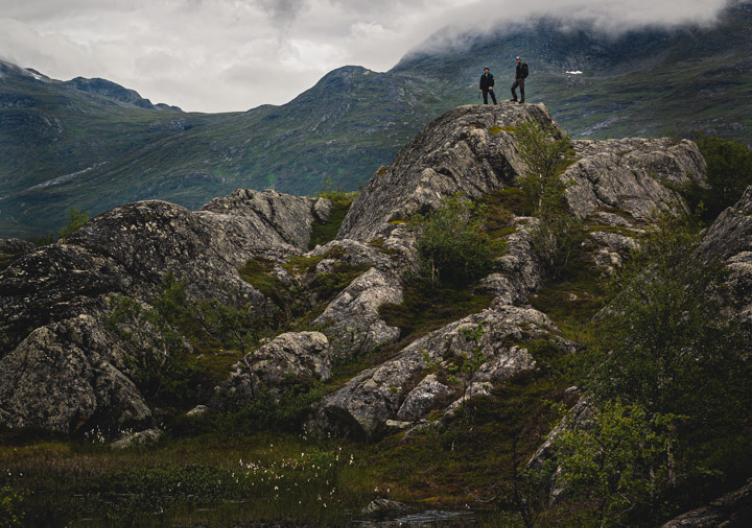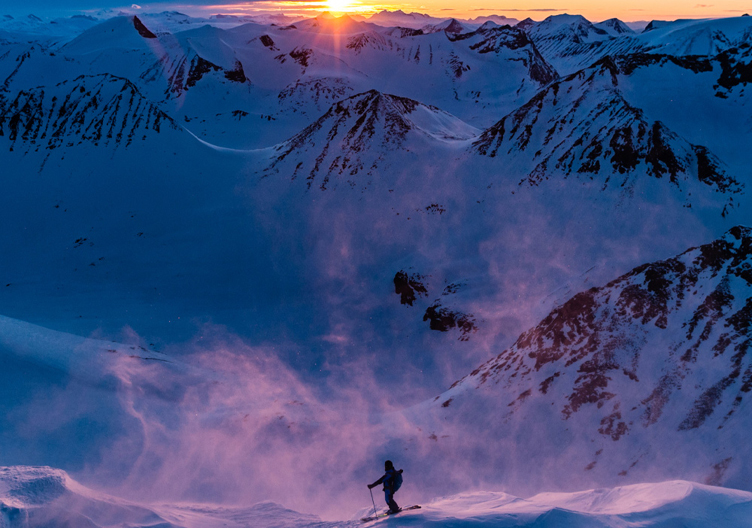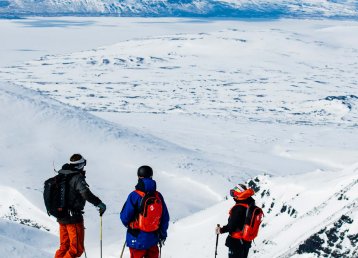Kiruna, April 7, 2024. It is a Tuesday in April and spring has made a sudden appearance in Kiruna. Cars have much in the same way made their appearance in the car park at the bottom of the Luossavaara ski slope. Skiers and snowboarders of all shapes and sizes are heading towards the chair lift. After a couple of runs on the smooth piste, with wonderfully melting snow, I walk into the café. It is quite empty, but I know for sure it will fill up during the course of the afternoon.
Even if Kiruna is a tourist magnet here in the north, Café Sport at Luossavaara is something of a locals’ joint at the end of the season. Janne Aikio, the manager, charges me for a coffee and a slice of carrot cake, and when he gets a brief break, he comes by for a chat. “Luossa” was the mountain of his childhood. This is where he learnt how to be a world-class free rider. Here, and in Riksgränsen of course. Because in Kiruna, if the Luossavaara slope is the tabernacle, then Nordalsbranten is the temple.
— It’s definitely a spot for locals, but you’d be surprised how many foreign guests come here in winter. People on rented skis dreaming of skiing underneath the northern lights.
A mountain to climb
There is a mountain to climb in almost every culture. Jesus held his most famous sermon on a mountain, and it is in this Sermon on the Mount we find our headline: “For whoever has, to him more shall be given, and he will have an abundance; but whoever does not have, even what he has shall be taken away from him.” Plain and unvarnished. Abraham crawled up onto a mountain to sacrifice his son, but in the end made do with a sheep. Moses saw a burning bush on a mountain and gave us the ten commandments.
"Mountains are essential in human culture"
Mountains are essential in human culture, and it does not take religion or anything else to understand that it is really all about guidance: guidance to the good life, with or without skis. When Buddha spoke to all the animals on Earth, he did so from a mountain, but the fish stayed in their streams. That is why fish is served very well done in many Buddhist countries – they cannot trust what is inside the fish. The Japanese have their Fuji, the Australians their Uluru, the Sioux their Black Hills and the Israelis their Sinai; the skiers in Kiruna have Luossa.
The rebels
Janne Aikio took his place in freeskiing history with ‘the jump’. A flight in Riksgränsen’s quarter pipe that ended up on the cover of Powder Magazine under the headline ‘The Next Big Thing’. Free riding had come to stay, and Janne Aikio hammered it home on the cover of the most important skiing magazine in the world.
— I’m not sure what my life, or many of my friends’ lives, would have shaped up to be if there hadn’t been a Luossavaara slope, Aikio continues.
— We were the rebels, not wanting to play ice-hockey.
If there had been no Luossa perhaps he would have just played ice-hockey, got a job in the mine, stayed. Not a bad life, as far as things go, but still not what he wanted. Janne competed in mogul skiing, but when the training session ended, he donned his snowboard and he was off. There were no unnecessary boundaries between the disciplines. You can see that same phenomenon on the mountain today. Alpine skiers train with snowboarders and free riders. This small mountain has created the necessary conditions for a number of Swedish team skiers as well as X Game winners.
Riksgränsen Banked Slalom
It’s all about carving. No jumps, no flips, no rails. Just the beautiful art of turning on a snowboard.
The only thing that counts
Sometimes we focus too much on size. The best male skier in the world, Ingemar Stenmark, had nothing but a slope to labour up at night at home in Tärnaby. Together with his neighbour Stig and all the other kids in Tärnaby, they packed that slope themselves. They created their own conditions, shaping their sense of snow. Lindsey Vonn’s home slope is Buck Hill in Minnesota with a vertical drop of 80 metres. That is also where Kristina Koznick, with six world cup victories, comes from. If you think that Pernilla Wiberg had a massive vertical drop at home in Yxbacken outside Norrköping, you are pretty far off. Or Mattias Hargin from Huddinge.
"The only thing that counts is if you really want to be there"
Quite the opposite: the only thing that counts is if you really want to be there. For real. Or in the words of Tomas Magnusson, who is a cross-country skier and calls a spade a spade, when he was asked if you could really become a good cross-country skier if you came from Motala: “Well, sometimes it snows so much that you can ski for several hours.”
A town on the move
I have no real ties to Kiruna, apart from the image you get from lessons in school and impressions from a couple of stops on my way to Riksgränsen and Abisko. Once upon a time this was the largest city in the world, in terms of surface area. A mine with the largest iron ore body in Europe provided conditions to build the ideal city. The first managing director of the mine, Hjalmar Lundbohm, is said to have stepped off the train and uttered: “But what a damn place.”
I sometimes wonder what it is like for people who fly in from other parts of the world. What are they thinking as they look out their window, and all they see are mountains and white and perhaps the northern lights? Then they land in the middle of a mining project and a town that is on the move. “What a damn place.” I have, of course, stayed a couple of times at Icehotel in the neighbouring village Jukkasjärvi. Very cool. I have had hamburgers at Empes going to and returning from Riksgränsen for nearly 30 years. I have been to Momma’s too; it is kind of a given if you grew up with that Ted Ström song. But I have no relationship with the town itself. What I know is mostly influenced by the detective novels written by Åsa Larsson.
Having said that, this warm April afternoon I find myself skiing at Luossa in Kiruna. The slopes on Luossa have been open for nearly six months. Janne Aikio says that if the season lasts until the middle of May, they will have been open for 200 days this year. The modern Kiruna, the town I passed last spring, looks different. The town skyline has changed: the famous Ralph Erskine buildings are gone. Here at Café Sport I have a burger and a cup of coffee, contemplating another run. Many skiers are middle-aged, the parents of the next generation rebels – perhaps even more of them are prospective rebels. In many ways it feels like I have ended up at a youth centre.
Aurora Safaris
If you take the traditional safari camp concept, founded in the deep traditions of traveling through Africa, and move it to the north, you get the award winning Aurora Safari.
The lights
There is Karin Stöckel, in the middle of all the youngsters. She is a trainer now, and this used to be her back yard too, when she was young and trained together with Ylva Ståhlnacke to become a skier. Ylva made the national team; Karin won the Scandinavian Big Mountain Championship in Riksgränsen.
— I could see the lift from home, growing up. It used to be the first thing I checked after school and once we’d had dinner. Would the light at Luossa come on, and the lifts open?
"It’s mostly about wanting to give something back, to the club, to Luossa"
Karin started to work in the mine. She became one of the “mining women” and a “Sommarpratare”. On August 9, 2022, she spoke on national radio about strong women and what it is like to be a woman at a workplace such as LKAB in the classic radio show “Sommar i P1”, a show dating back to 1959. An interesting story. To someone on the outside it is nearly impossible to understand how the mining giant has the financial muscle to move an entire town for billions but is unable to provide protective clothing that works for women in the mining industry. Karin and I have lunch at the cultural centre Aurora one day. They serve “blodpalt”, like a dumpling made out of reindeer blood, and pork. She is delighted:
— But it remains to be seen if their black dumplings are as tasty as my grandmother’s.
Her family comes from Kattuvuoma on the northern side of lake Torneträsk. A family of Sami and settlers. Hard workers.
— My aunt always used to say: “Every single woman in our family would have been able to do the military service for sure.”
— It has somehow nurtured a kind of independence, knowing that I – just like the rest of the women in our family – can withstand more than just a little.
To give something back
As I am sat talking to Karin, I understand that the class struggle is important and what the mining women did was to make their presence known. This might not always have been what the mining giant wanted, as it protected its trademark. We might not discuss skiing much as we enjoy our dumplings, but it is easy to understand why she had no fear of going for it, on the mountain.
Her first summer job as a teenager was driving a 20-tonnes dumper truck one kilometre below the mining mountain, with only a fairly short training period beforehand. If you get that kind of mountain experience, a feeling for whether the mountain is stable a thousand metres below ground, it might not matter much if you stand on a mountain top and there is a bit of a slope. I ask her about her role as a trainer.
— I have two kids. One likes skiing, the other one doesn’t. I suppose it’s mostly about wanting to give something back. To the club. To Luossa.
Mattias Fredriksson
This is the story of how lifestyle photographer Mattias Fredriksson’s career took off in Riksgränsen back in 1990s.
A time of change
The next day I amble over to the ski slope again. There is something nice about a slope that is open in the evenings, and a café with burgers and crisps. Janne Aikio and I talk a bit more about skiing and about Kiruna. Snowboarder Björn Lindgren walks in and takes a seat. His children are there, snowboarding. He is also one of many who have been raised by this mountain and are now trying to get the mountain to do the same with their own children.
"It was a time of change – I skied but wanted to snowboard
In 1994, when he was 13, Björn entered a snowboarding competition organised by the clothing brand Diesel in cooperation with MTV, in Riksgränsen. Several of the world’s best snowboarders were there. Björn sent jumps like only a 13-year-old can. He got a contract with one of the largest snowboarding brands in the world.
— It was a time of change. I skied but wanted to snowboard. My dad gave me 500 SEK to enter the slalom competitions. So I went, in baggy clothes and never bothered with the speed suit. In the end he understood that it wasn’t worth any more money.
Who you are
Snowboarding won in the end. Björn went all around the planet as a sponsored snowboarder. But he was not a big fan.
— It was lonely. My sponsor would give me a plane ticket “go there and do it”. For a while it’s fun, but then…
— It might come down to who you are. I’ve always been fond of Kiruna and the mountains, so in the end I knew I just wanted to be at home.
These days Björn has two daughters to ride with. His oldest daughter Isa is an excellent snowboarder, too. She started out skiing. I ask if he tried the old ‘500 trick’ with his daughter when she wanted to give up skiing and just snowboard, and he laughs.
— Isa spends 3-4 evenings per week here at Luossa. We have an apartment in Riksgränsen and go there on weekends. She spends 5-6 days per week on her snowboard, from November to May.
— I would be stupid trying to take the mountain from her. If anyone knows what it means, it’s me.






























